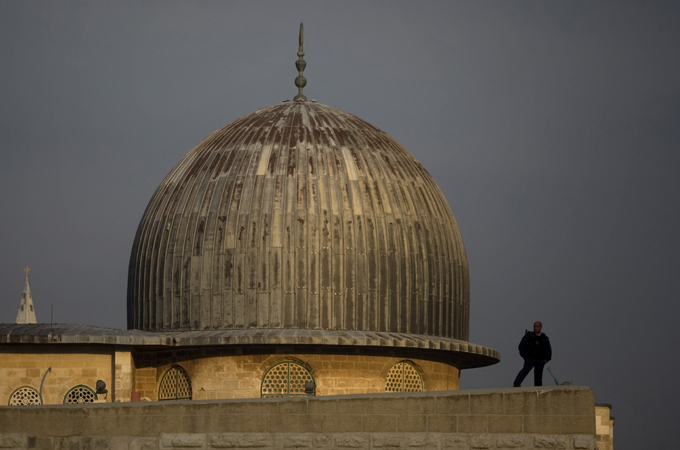Israel/Palestine
Related: About this forumTimeline: Al-Aqsa mosque
10/30/2014
Al-Aqsa mosque undergoes first renovation in 20th century

A review of the critical events that have marked the history of al-Aqsa mosque in Jerusalem.
Dalia Hatuqa and Mohsin Ali Last updated: 30 Oct 2014
Jerusalem's Old City, founded around 4,000 BC, is an area of great significance to people from the three monotheistic religions: Islam, Judaism and Christianity. It is divided into four quarters (Muslim, Christian, Jewish and Armenian) and is surrounded by walls. Eleven gates lead into the Old City, and seven of these are open today.
Inside the Old City, a World Heritage site, lies al-Haram al-Sharif, or the Noble Sanctuary, a 35-acre compound that comprises Islam's third holiest site, after Mecca and Medina in Saudi Arabia, al-Aqsa mosque. The compound is also home to the Dome of the Rock, a revered site believed to be where the Prophet Muhammad ascended to heaven.
Since Israel occupied the West Bank, East Jerusalem, and the Gaza Strip in June 1967, the affairs of the Noble Sanctuary have been run by an Islamic trusteeship, supported by the Jordanian government, known as the Waqf. Israel still maintains what it believes to be its right to sovereignty over the area after it annexed the eastern part of the city.
In addition to running schools and charities in Jerusalem, the Waqf maintains guards at the entrances to the compound, with the exception of the Mughrabi Gate. This gate (also known as Bab al-Magharbeh or Dung Gate) is connected by a bridge to an open-air plaza that was created when Israel demolished the Mughrabi (Moroccan) Quarter in 1967.
in full: http://www.aljazeera.com/news/middleeast/2014/04/timeline-al-aqsa-mosque-2014413111757867796.html
azurnoir
(45,850 posts)but there is much valuable information too
sabbat hunter
(6,829 posts)Aljazeera chose to ignore things happening on the Temple Mount (and under it) done by the Muslim authorities and muslims on the temple mount. Like the rock throwing by muslims off the top of the wailing wall on to jewish worshippers on the plaza below in the 80's. Or the Muslim authorities digging under the temple mount, destroying ancient ruins and causing problems with the wailing wall (like it to bulge in places).
If they want to paint a picture of critical events at the al-aqsa mosque, they should have included those, among others, done by the muslim authorities and muslims, as well as what the Israeli government, and some jews have done.
Jefferson23
(30,099 posts)post it in this thread. I would appreciate it, the more information the better..thanks.
sabbat hunter
(6,829 posts)Solomon's stables from wikipedia
(solomon's stables is the area under the temple mount, given the name by medieval crusaders)
In 1996, the waqf built a modern prayer hall there, with a capacity for 7,000 worshippers.
The Southern Wall of the Temple Mount showing damaged area and criticized repair job as a bright white patch to right
In 1997, the waqf began digging up the southeastern area of the Temple Mount, drawing criticism from archaeologists, who said that archaeological finds were being damaged in the process and the excavations weakened the stability of the Southern Wall. The excavations are thought to have been responsible for creating a large, visible bulge in the Southern Wall that threatened the structural integrity of the Temple Mount, necessitating major repairs. The repairs have been called "unsightly", an "eyesore", and a "terrible job" because they appear as a large, bright, white patch of smooth stones in a golden tan wall of rusticated ashlar.
More here about what is going on under the Temple Mount.
http://www.smithsonianmag.com/history/what-is-beneath-the-temple-mount-920764/?page=2
Yusuf Natsheh, the Waqf’s chief archaeologist, was not present during the operation. But he told the Jerusalem Post that archaeological colleagues had examined the excavated material and had found nothing of significance. The Israelis, he told me, were “exaggerating” the value of the found artifacts. And he bristled at the suggestion the Waqf sought to destroy Jewish history. “Every stone is a Muslim development,” he says. “If anything was destroyed, it was Muslim heritage.”
Zachi Zweig was a third-year archaeology student at Bar- Ilan University, near Tel Aviv, when he heard news reports about dump trucks transporting Temple Mount soil to the Kidron Valley. With the help of a fellow student he rounded up 15 volunteers to visit the dump site, where they began surveying and collecting samples. A week later, Zweig presented his findings—including pottery fragments and ceramic tiles—to archaeologists attending a conference at the university. Zweig’s presentation angered officials at the Israel Antiquities Authority (IAA). “This is nothing but a show disguised as research,” Jon Seligman, the IAA’s Jerusalem Region Archaeologist, told the Jerusalem Post. “It was a criminal deed to take these items without approval or permission.” Soon afterward, Israeli police questioned Zweig and released him. By that point though, Zweig says, his cause had attracted the attention of the media and of his favorite lecturer at Bar-Ilan—the archaeologist Gaby Barkay.
I bolded a portion of the above because it shows the disregard the Muslim authorities show to any Jewish historical connection to the Temple Mount.
As for the rocks thrown in the 1980's, I was there when that was going on, so it is an eyewitness account.
azurnoir
(45,850 posts)even though most other epochs are covered
Barkay says some discoveries provide tangible evidence of biblical accounts. Fragments of terra-cotta figurines, from between the eighth and sixth centuries B.C., may support the passage in which King Josiah, who ruled during the seventh century, initiated reforms that included a campaign against idolatry. Other finds challenge long-held beliefs. For example, it is widely accepted that early Christians used the Mount as a garbage dump on the ruins of the Jewish temples. But the abundance of coins, ornamental crucifixes and fragments of columns found from Jerusalem’s Byzantine era (A.D. 380–638) suggest that some public buildings were constructed there. Barkay and his colleagues have published their main findings in two academic journals in Hebrew, and they plan to eventually publish a book-length account in English.
http://www.smithsonianmag.com/history/what-is-beneath-the-temple-mount-920764/#rrawezBeHbB8CvwS.99